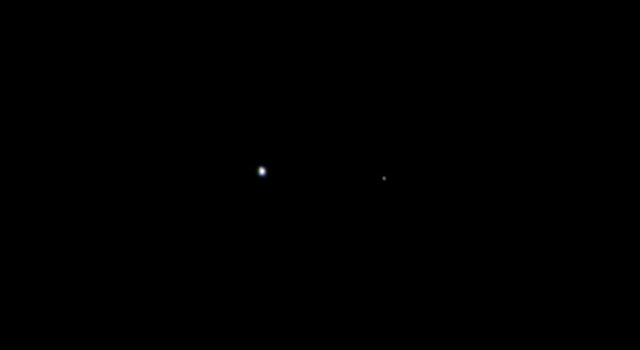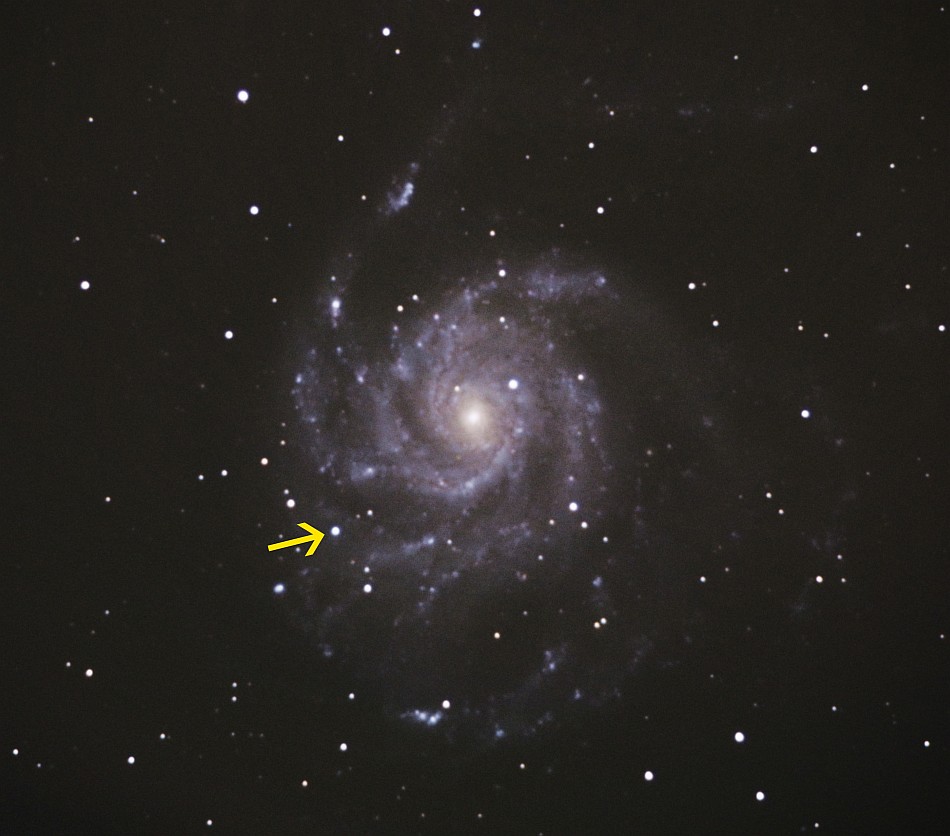 | |
|  |
|
|
| |
| Death of a comet, a star, and bye-bye Earth | Sep 01, 2011 1:19 AM PDT | url |
| | |
Added 1 new A* page:Recent space news happenings!
~~~~~
The comet Elenin, (or C/2010 X1, if you like) just discovered by an amateur Russian astronomer last year, appears to have disintegrated; observers report its core has become "elongated and diffuse," and in the past week it has declined in brightness by 50%. The sun-watching STEREO-B satellite had been tracking Elenin as it neared the Sun, and captured this video on the 19th of August, in which Elenin, I think the brightish dot in the middle, appears to be hit by a coronal mass ejection--you can see an abrupt increase in material coming off the comet:
video on Youtube
If it is breaking up, it wouldn't be an entirely unusual occurrence for comets flying into the hot mouth of the solar wind; this was observed to happen to comet C/1999 S4 (LINEAR) back in 2000, for instance. Elenin is due to reach perihelion--its closest point to the Sun--on September 10th, when it will be 72 million km (45 million miles) from the Sun; that's about midway between Earth's orbit and the Sun, and just a little further away from the Sun than the orbit of Mercury.
Elenin had been estimated by its discoverer, Leonid Elenin, to be about 3-4 km in diameter, and it had been expected to loop back toward Earth, coming within 35 million km (22 million miles) of our planet on October 16th. That isn't really very close ("slightly closer than the planet Venus") but it didn't stop a number of doomsday predictions being made in relation to the comet! :P Elenin would have been far too faint to see with the naked eye even if it had been intact at its closest approach, but now it's an open question as to just how much--and in how many pieces--of the comet will be left when gravity brings it back around.
~~~~~~~~
NASA's recently launched Jupiter probe, Juno (remember, it's the one that launched on August 5th, with the custom LEGO figures on board), on its way to the giant planet, turned its camera around and captured this photo of the Earth and Moon together, as seen from about 10 million km (6 million miles) away:

image by NASA (source)
And for some more perspective on the distances involved, NASA JPL's article on the photo adds: "Juno covered the distance from Earth to the moon (about 250,000 miles or 402,000 kilometers) in less than one day's time. It will take the spacecraft another five years and 1,740 million miles (2,800 million kilometers) to complete the journey to Jupiter."
~~~~~~~~
On the 24th, the Palomar Transient Factory, a project at California's Palomar Observatory described as "an automated telescopic survey that scans the sky for transient and variable astronomical events," detected SN 2011fe, a white dwarf star 21 million light years away in Messier 101, aka the Pinwheel Galaxy, undergoing a supernova explosion. "It was observed by the PTF survey very near the beginning of its supernova event, when it was approximately 1 million times too dim to be visible to the naked eye. It is the youngest type Ia ever discovered. [...] One day later, on 23 August 2011, it was 10 thousand times too dim. On 24 August 2011, it was 6 times brighter than that. It is expected to be visible with strong binoculars within several weeks of discovery."
Here's how the supernova looked to one astronomer on the 25th:

image by Thunderf00t (source)
A type Ia supernova is the supernova of a white dwarf star; these events are very important to astronomers, because the exploding stars are thought to have a nearly uniform mass: nearly 1.38 solar masses, aka the Chandrasekhar limit, the point at which a white dwarf's nuclear reactions could no longer support its own weight, and it would collapse, triggering a supernova.
Actually, though, it is now thought that the Chandrasekhar limit is never quite reached; instead, when the accreting white dwarf star, which is usually a cooling, electron-degenerate (so dense that its atoms are squeezed tightly together, held apart only by their orbiting electrons) mass of carbon and oxygen left over from the death of a small to medium-mass star, gets within about 1% of the limit, a period of convection--internal currents, I guess--begins, lasting about 1000 years. At some point during that relatively brief time, its carbon, and then its oxygen, begin to undergo nuclear fusion; the incredibly dense carbon/oxygen material making up the star fuses into heavier elements in just a few seconds, releasing more than enough energy to blow the star apart as a supernova.
Anyway, because they occur at pretty much exactly the same size, this type of supernova also has pretty much exactly the same brightness, "about 5 billion times brighter than the Sun." Their brightness to an observer on Earth, then, varies more or less only by how far away they are. To an astronomer, this means that if they spot one, all they need to do is measure its brightness, and they'll know how far away it is, making them very handy for getting highly accurate readings of distances to other galaxies, and so forth. It was an analysis of type Ia supernovae, for instance, that convinced the science world in 1998 that the universe is expanding at an increasing rate (that was the follow-up to Edwin Hubble's 1929 discovery, based on an analysis of the redshift of various galaxies, that more distant objects are moving away from us more rapidly, ie that the universe is expanding).
So, because SN 2011fe was found so early in its explosive life, and because it is so close, relatively, astronomers studying it should be able to refine their measurement of the mass, luminosity, and other characteristics of these supernovae, which in turn will enable them to make more accurate estimates as to the expansion and mass of the universe--perhaps getting us closer to certainty on some fascinating and ultimately important questions such as what comprises the parts of the universe we can't see, and what is our universe's ultimate fate.
|
·····
|
|
|
